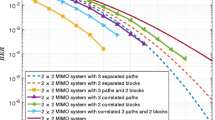We consider the problem of designing high rate space–time block codes in multipath fading channels. For this, both minimizing the effect of the self-interference induced by the code itself, and mitigating the inter-symbol-interference induced by the channel have to be addressed. We translate the problem into an equivalent problem of designing a constrained code in a single-path channel with more antennas, and argue that design criteria derived in single-path apply when optimizing this constrained code. Here we concentrate on an analytic measure pertinent to mutual information maximization and BER-performance optimization. The design program is successfully applied to rate one linear space–time transmissions from four transmit antennas. A family of discrete permutations of the transmitted sequences are considered. Performance is optimized within this family, and the results are seen to effect directly both mutual information and error performance.








Similar content being viewed by others
References
Tarokh V., Seshadri N., Calderbank A.R. (1998). Space–time codes for high data rate wireless communication: performance criterion and code construction. IEEE Transactions on Information Theory 44:744–765
Alamouti S. (1998). A simple transmit diversity technique for wireless communications. IEEE Journal on Selected Areas in Communication 16:1451–1458
Lindskog E., Paulraj A. (2000). A transmit diversity scheme for channels with intersymbol interference. IEEE International Conference on Communications (ICC) 1:307–311
Vook F.W., Thomas T.A. (2000) Transmit diversity schemes for broadband mobile communication systems. IEEE Vehicular Technology Conference 6:2523 – 2529 Fall
Naguib A. (2001). On the matched filter bound of transmit diversity techniques. IEEE International Conference on Communications (ICC) 2:596 – 603
Zhou S., Giannakis G.B. (2001). Space–time coding with maximum diversity gains over frequency-selective faading channels. IEEE Signal Proceedings Letters 8(10):269 – 272
Diggavi S.N., Al-Dhahir N., Calderbank A.R. (2003). Algebraic properties of space–time block codes in intersymbol interference multiple access channels. Transactions on Information Theory 49(10):2403–2414
N. Al-Dhahir, Single-carrier frequency-domain equalization for space–time block-coded transmissions over broadband wireless channels, IEEE International Symposium on Personal, Indoor, and Mobile Radio Communication (PIMRC), pp. 143–146, 2001
Tarokh V., Jafarkhani H., Calderbank A.R. (1999) Space–time block codes from orthogonal designs. IEEE Transactions on Information Theory 45:1456–1467
O. Tirkkonen, A. Boariu and A. Hottinen, Minimal non-orthogonal rate 1 space–time block code for 3 + Tx antennas, IEEE 6th International Symposium on Spread-Spectrum Techniques and Applications (ISSSTA), Vol. 2, pp. 429–432, 2000
Jafarkhani H. (2001). A quasi-orthogonal space–time block code. IEEE Transactions on Communications 49:1–4
O. Tirkkonen, Optimizing space–time block codes by constellation rotations, Finnish Wireless Communication Workshop, pp. 59–60, 2001.
Hassibi B., Hochwald B. (2002). High-rate codes that are linear in space and time. Transactions on Information Theory 48(7):1804–1824
Hottinen A., Tirkkonen O., Wichman R. (2003). Multiantenna Transceiver Techniques for 3G and Beyond. John Wiley and Sons, Chichester
El Gamal H., Damen M.O. (2003). Universal space–time coding. Transactions on Information Theory 49(5):1097–1119
E. Lindskog and D. Flore, Time-reversal space–time block coding and transmit delay diversity-separate and combined, 34th Asilomar Conference on Signals, Systems and Computers, pp. 572–577, 2000
A. Hottinen and O. Tirkkonen, Precoder designs for high rate space–time block codes, Princeton Conference on Information Sciences and Systems (CISS), 2004
S. Iraji, O. Tirkkonen, A. Hottinen and K. Kuchi, Non-orthogonal space–time block code for multipath channel, IEEE International Symposium on Personal, Indoor, and Mobile Radio Communication (PIMRC), Vol. 4, pp. 2303–2307, 2004
O. Tirkkonen and R. Kashaev, Combined information and performance optimization of linear MIMO modulations, IEEE International Symposium on Informations Theory (ISIT), p. 76, July 2002
O. Tirkkonen and M. Kokkonen, Interference, information and performance in linear matrix modulation, IEEE International Symposium on Personal, Indoor, and Mobile Radio Communication (PIMRC), Vol. 1, pp. 27–32, September 2004
S. Sandhu and A. Paulraj, Space–time block codes: a capacity perspective, IEEE Communication Letters, Vol. 4, No. 12, December 2000
Author information
Authors and Affiliations
Corresponding author
Rights and permissions
About this article
Cite this article
Tirkkonen, O., Iraji, S. & Hottinen, A. Design Criteria for Non-Orthogonal Space–Time Block Codes in Multipath Channels. Int J Wireless Inf Networks 13, 341–355 (2006). https://doi.org/10.1007/s10776-006-0043-0
Published:
Issue Date:
DOI: https://doi.org/10.1007/s10776-006-0043-0




